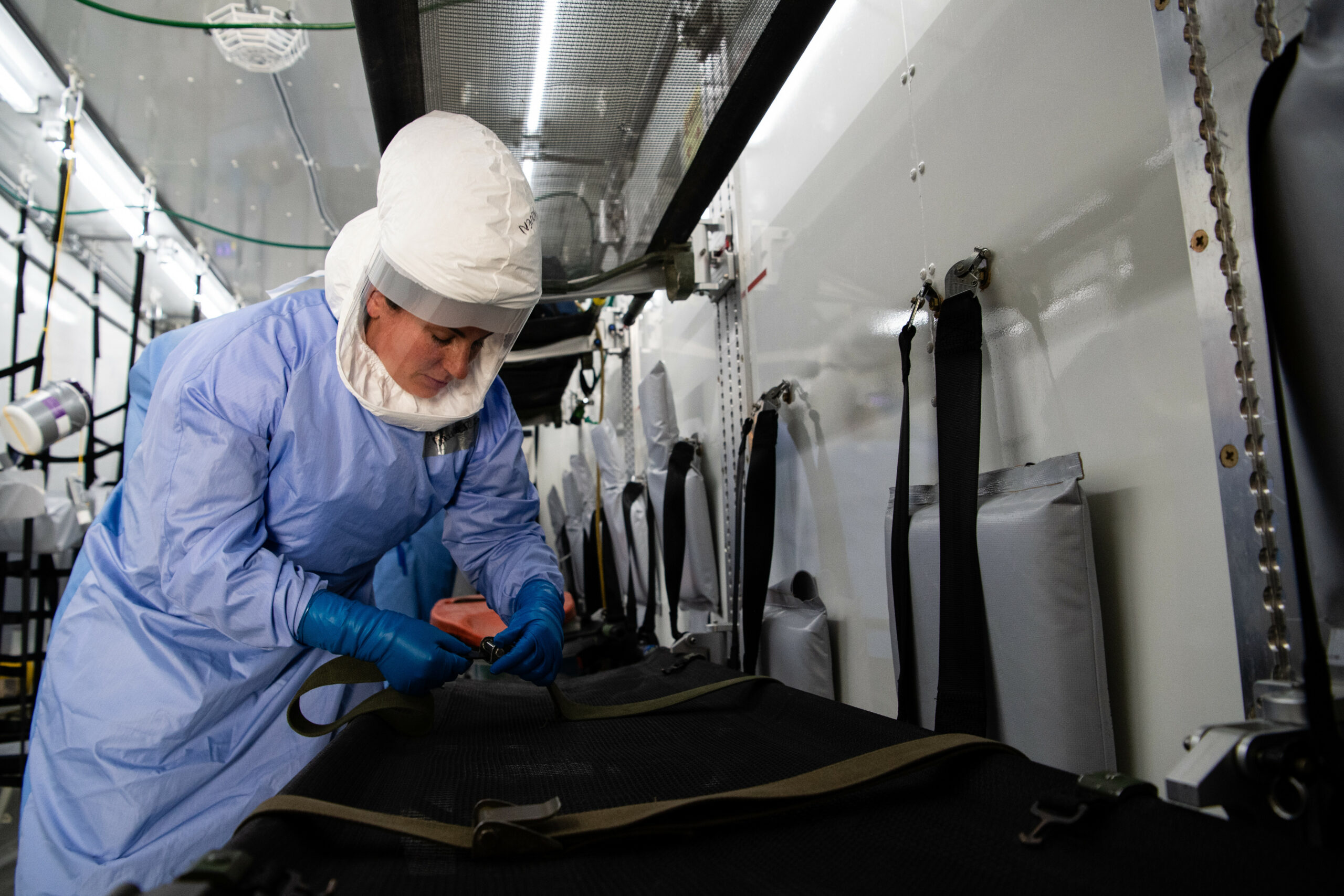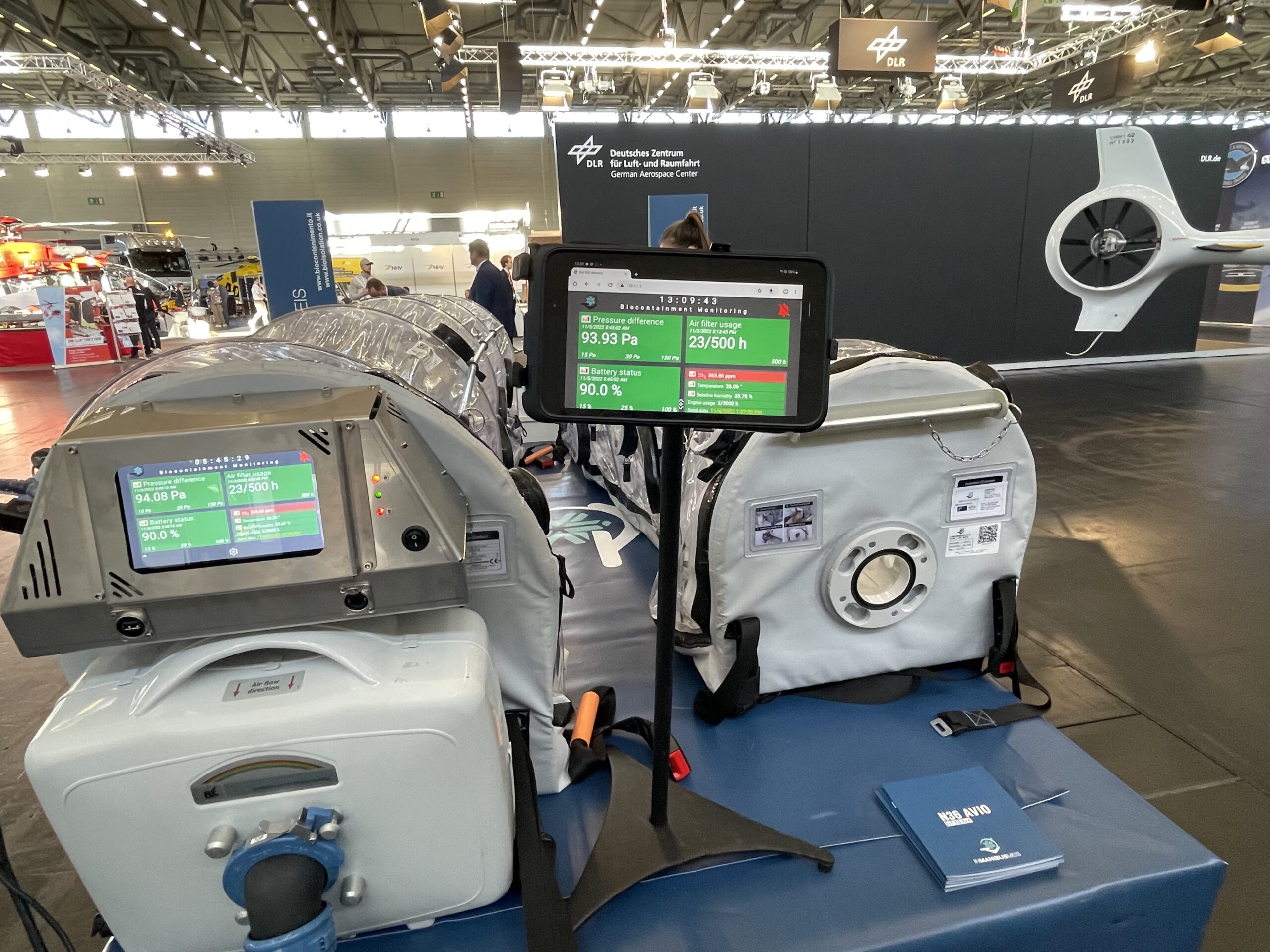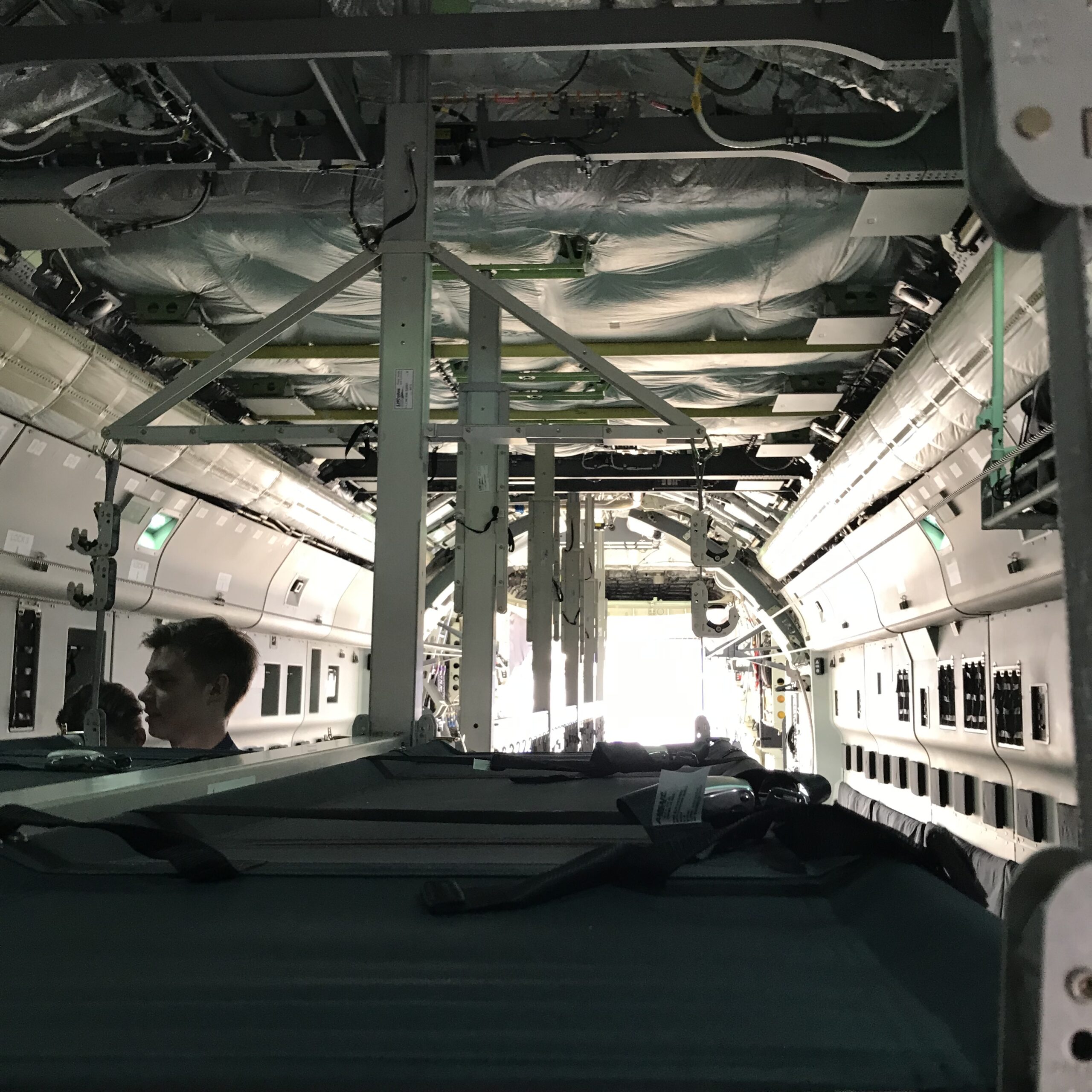When the COVID-19 pandemic gripped the globe, the military in many countries supported the civilian authorities in many roles, from assisting medical professionals, to enforcing the lockdown, and in general law and order support roles. In providing support to doctors, nurses, and paramedics, the military also transported patients both on the ground and in the air.
Royal Responsiveness
In the United Kingdom, the National Health Service (NHS) quickly found itself overwhelmed as cases rose, especially with hospital admissions. On 23 March 2020, Prime Minister Boris Johnson announced the country would enter lockdown, with the general public having to stay inside their homes except for essential journeys, and to isolate from all contact with others if they felt any symptoms, for a proposed period of 12 weeks. Those not restricted by these new rules were classified as ‘key workers’, which included medical and hospital personnel, engineers, and public sector workers. To assist in the effort to combat the virus, the Ministry of Defence (MoD) mobilised units to support the civilian authorities. The Aviation Task Force was formed in Scotland, the north of England and in the south of the country.
All battlefield support helicopters in the UK fall under the Joint Helicopter Command (JHC), be it the Army Air Corps (AAC) Boeing Leonardo (AgustaWestland) WAH-64D (and soon to be Boeing AH-64E Guardian), and the Leonardo AW159 Wildcat, the Royal Air Force Boeing Chinook (MK4/5/6), and Airbus Helicopters Puma HC2, or the Royal Navy Fleet Air Arm (FAA) Leonardo Merlin MK3 and MK4, and Leonardo AW159 Wildcat. The JHC established the Aviation Task Force COVID Support Force (ATF CSF).
On the 27 March 2020, an Aviation Task Force comprising three Royal Air Force (RAF) Puma HC2 aircraft, was stationed in northeast Scotland at Kinloss Barracks (a former Royal Air Force station), near the Moray Firth. In Edinburgh, a team of military and military staff planners/liaison officers established themselves at the Scottish Government headquarters building in St Andrew’s House. Their role was the coordination of Medical Evacuation (MEDEVAC)/EMS (Emergency Medical Service), moving large groups of patients for treatment, plus the transportation of important equipment and medical personnel.

Credit: RAF
At the same time, further south at RAF Leeming in North Yorkshire, a single RAF Boeing Chinook heavy lift helicopter and an Army Air Corps (AAC) AW159 Wildcat multi-mission, light battlefield helicopter, were stationed to support civilian authorities in that part of the United Kingdom. Further south, in Oxfordshire at RAF Benson, a second Aviation Task Force Headquarters was established, as a second base to cover the south of the country.
RAF Benson is home to No.28 Squadron (Boeing Chinook) and No.33 Squadron, as well as No.230 Squadron (Airbus Helicopters Puma HC2), and the newly reformed No.22 Squadron (formerly Rotary Wing Operational Test & Evaluation Unit). Another unit based at RAF Benson is the Joint Helicopter Support Squadron (JHSS), which supports all rotary wing operations occurring at this time, plus elements of a Tactical Supply Wing from a base in the West Midlands. Protecting the aircrew, medical personnel, and patients from infection was paramount, and measures included decontamination of aircraft, personnel and uniforms in accordance with medical guidelines.
The Royal Air Force is no stranger to aeromedical missions with biohazards. During the 1980s, aircraft of the Air Transport (AT) fleet, based at RAF Brize Norton in Oxfordshire, were equipped with the legacy Vickers VC-10 four-jet tanker transport aircraft, which was later used in the repatriation from Africa of a British nurse infected with a virus. With the retirement of the Vickers VC-10 K2 and the three-engine Lockheed L-1011 Tristar, the AT fleet now consists of the multi-engine Airbus A330-200 Voyager Multi-Role Tanker Transport (MRTT), operated by both 10 and 101 Squadrons. The Boeing C-17A Globemaster III four-engine strategic transport operated by 99 Squadron, also at Brize Norton, carries out aeromedical evacuations if tasked, likewise with the Airbus Defence four-engine turboprop A400M Atlas.
The RAF has the Deployable Air Isolator Team (DAIT), dedicated to the transport of patients with possible or confirmed highly infectious diseases back to the UK. Since 2012, the DAIT, a joint Department of Health (DoH) and Ministry of Defence asset, has successfully transferred a case-patient with the Crimean-Congo haemorrhagic fever, five case-patients with the Ebola virus, and five case-patients with high-risk Ebola virus exposure. Currently, no UK-published guidelines exist on how to transfer such patients. The DAIT therefore has procedures from collection at point of illness or exposure, to delivery into a dedicated specialist centre.
Air Force Nightingales
In the United States Air Force (USAF), Air Mobility Command (AMC) is responsible for global airlift and air-to-air Refuelling (AAR) across the armed services of the United States and their allies. Across their fleet of multi-engine jet and turboprop transport aircraft, it is predominantly the six decade old legacy four engine Boeing KC-135R/T Stratotanker, Boeing C-17A Globemaster III, Lockheed-Martin C-5M Super Galaxy heavy strategic airlifter and the four turboprop Lockheed-Martin C-130H/J Hercules/Super Hercules which are used in the aeromedical evacuation role.
The aeromedical mission was added with the introduction of the new twin-engine Boeing KC-46A Pegasus with the first aeromedical mission conducted by a Pegasus belonging to the 22nd Air Refuelling Wing (ARW) at McConnell Air Force Base (AFB) in Kansas. The mission involved transporting patients between Joint Base (J-B) Andrews in Maryland, to Naval Air Station (NAS) Norfolk in Virginia, and across the other side of the country to Travis AFB in California.
The Distinguished Visitor (DV) Bombardier C-21A Learjet twin-engine executive transports, which are deployed at headquarters bases, such as at the United States Air Forces in Europe & Air Forces Africa (USAFE-AFAFRICA) at Ramstein Air Base (AB) in the Eifel region in Germany, has been tasked for rapid emergency aeromedical missions. The demise of the small Beechcraft C-12 King Air turboprop fleet in the USAF leaves only a small number of available aircraft, but the C-12J in service with the 374th AW at Yokota AFB in Japan, does have a secondary aeromedical role within the Pacific region.

Credit: USAF/Staff Sgt. Justin Parsons
Up until 2005, the USAF had a dedicated flying air ambulance in the form of a four-decade old twin-engine McDonnell Douglas C-9B Nightingale (based on the successful DC-9 airliner). After its retirement, the even older KC-135R/T Stratotanker has taken on the secondary mission (or third role if counting the tanker and small transport) of medical evacuation, with the cabin converted to take stretchers and equipment.
United States Air Force School of Aerospace Medicine (headquartered at Wright-Patterson AFB in Dayton, Ohio), trained medics on the use of the Transport Isolation System (TIS), which was entered service in 2014 at the time of an increased outbreak of the deadly Ebola virus on the African continent. The United States Africa Command (AFRICOM) initiated Operation Unified Assistance in response to the outbreak, to move and repatriate patients to the United States.
The TIS allows medical personnel to use all medical supplies and equipment carried by Aeromedical Evacuation (AE) crews and Critical Care Air Transport Teams, and allows for the same level of care available on any USAF AE mission. The TIS can be installed in the AMC fleet of C-130H/J Hercules/Super Hercules and C-17A Globemaster III (additionally, the C-17 is able to transport two TIS units). The infectious disease containment unit is designed to minimise the risk to AMC aircrew and medical personnel, while transporting and allowing in-flight medical care for patients infected with dangerous diseases and viruses such as COVID-19. The set-up consists of a single antechamber module (AM) complete with two isolation modules (IM), with each one on its own modified 463L aircraft pallet. In order to contain both the airborne and non-airborne pathogens, the pallets are retrofitted with watertight enclosures and high-efficiency particulate air (HEPA) filtration systems. The AM ensures that the medical personnel have an enclosed space to safely decontaminate and remove their personal protective equipment (PPE) before exiting, while the IMs are where treatment and care of the patients are conducted. Each TIS can hold two litter patients, stacked securely for evacuation, or four ambulatory patients, meaning those who can walk with little to no need of assistance.
European Responders
During the COVID pandemic, Spain and Italy were among the hardest-hit in Europe, with massive numbers of infected and dying patients. The Spanish Army (Ejercito) has a specialist unit called UME (Unidad Militar de Emergencias), Military Emergencies Unit, which in normal times consists of mountain rescue teams, firefighters, paramedics and an operating fleet of multi-engine Airbus Helicopters AS532UL Cougar battlefield medium-lift/utility helicopters (based on the Super Puma family). The Army also has the smaller twin-engine H135 (EC135), commonly used across the globe in the para-public marketplace. The UME were out in force serving in the local communities, wearing protective Tyvek suits and respirators, while their aviation unit with the Cougar were performing medical evacuation with specialist incubator units.
In Italy, the armed forces, in particular the Army (Esercito) and Italian Air Force (Aeronautica Militare Italiana) were also hard at work. The latter was utilising the Leonardo HH-101 Caesar (AW101 Merlin family) three-engine Combat Search and Rescue (CSAR) helicopter, primarily for the Casualty Evacuation (CASEVAC) role. To deal with the emergency, a temporary hub was created at the Cervia air base, with HH-101 helicopters always ready for departure 24 hours a day, together with crews of the 9th and 15th wings, and medical and nursing personnel of the Italian Armed Forces specialised in transport and biocontainment. The activities were coordinated by the Poggio Renatico Air Operations Command, the nerve centre of the Armed Forces which, through its Air Operation Centre, receives and evaluates the requests from hospitals, prefectures and, during this health emergency, also by the Civil Protection authorities. These interventions were included in the broader framework of the support activities of the Armed Forces in the health emergency in Italy, offering an important contribution to the plans put in place by the Ministry of Defence in support of the Ministry of Foreign Affairs, Health and Civil Protection.

Credit: Aeronautica Militare Italiana
An example of how one company responded to the emergency can be seen with IN MM, an innovative Italian and British medical company, established in 2013, and operating in the Emergency and Military medical sectors. According to its founder and owner, Sabrina Menghini, who is a graduate of the NATO Centre of Excellence for Military Medicine in Budapest, Hungary, their company is constantly evolving with research and development to improve and invent new technological solutions. One such solution that IN MM provided in this instance was bio-isolation chambers, including stretchers and bio-isolated vehicles. The bio-isolation products are able to be rapidly deployed and provide a safe environment for patients and staff in the vicinity. The systems provide a drastically reduced risk of cross-contamination once installed.
After the experience of the recent pandemic, IN MM have modified the isolation stretcher, model IsoArk N36 (mainly intended for road ambulances), to meet the requirement to be safely loaded onto helicopters and aircraft, by creating the N36 AVIO version. This version helps to increase the capabilities of performing air evacuations of an infected patient from remote areas, or to simply guarantee quicker transportation to hospitals and medical facilities while maintaining the safety of the internal conditions of the aircraft. It is the ideal solution for transporting infected patients, or those with suspected infections, in a high level of biocontainment. Just one operator can deploy the stretcher in a few minutes, making it a perfect piece of equipment to be used in emergency conditions.

Credit: Ian V Frain
The IN MM N36 AVIO version has since been modified to be safely loaded on both fixed and rotary wing aircraft. The new internal and external configuration has been designed and produced, starting from the original OEM design, to help complete an entire system. These adaptations also include SHIELD, a protective flame-retardant and stain-resistant coating, which protects while maintaining transparency and flexibility.
Internal and external restraints are installed on the OEM system bases in both directions (transversal and longitudinal), in order to withstand manoeuvring loads and emergency crash conditions. A bio system is integrated with the N36 AVIO, which is key to ensuring safety during flight in an emergency, increasing the safety of biocontainment through a series of sensors that measure (but are not limited to) negative pressure, CO2 levels, as well as ventilation and filtered air levels. Changes to these outside accepted limits triggers an alarm system.
The system guarantees multi-platform transport and transfer within different scenarios, being interoperable between air, land and sea. The installation of the N36 AVIO version and its retainers does not affect the aircraft’s performance. Evacuation tests have already been performed on business jets, to prove that the height increase does not affect the egress procedure. This aircraft was selected specifically in order to have as small a volume as possible in a cabin, in conjunction with a small door, a ‘worst case scenario’ test.
Latin American Ambulatory Airlift
In South America, Brazil was one of the countries hardest hit by COVID. At the beginning of the pandemic, the Brazilian Air Force (Forcea Aerea Brasileira), participated in Operation Return to the Beloved Homeland Brazil, which involved repatriating 34 Brazilian nationals from the Chinese epicentre of the virus, Wuhan itself. This involved using a pair of Embraer VC2 (E190 Legacy) twin-engine Distinguished Visitor (DV) jets flying into the Anapolis Air Base where they would be quarantined for 18 days. The Chemical Biological Radiological Nuclear (CBRN) specialist unit of the Brazilian Navy (Marinha do Brasil) set up isolation facilities and medical facilities. Thereafter, the same unit was responsible for assisting the civilian authorities with the pandemic, from providing medicinal aid to the indigenous communities, transportation of patients, and the sanitary cleaning of public areas such as schools, hospitals, medical clinics, doctors’ surgeries, as well as airports, bus and railway stations.
The Air Force has made use of every transport aircraft across its fleet from the newest twin-engine heavy transport C-95 (Embraer EMB-110), C-97 (Embraer EMB-120), single-engine C-98 (Cessna C-208), C-99 and twin-engine jet VC-99 (Embraer EMB145), twin-turbo propeller C-105 and SC-105 (Airbus Defence C-295), Lockheed Martin C-130 and twin-jet engine strategic transport Embraer KC-390. These were adapted to transport patients across the large expanses of the country.

Show 2019, configured for medical evacuation.
Credit: Ian V Frain
A centralised call centre was created for Air Force health system users to not only provide information and psychological support (through chats and electronic messaging), to families whose relatives were hospitalised, but also training for specialised military and civilian personnel. A close liaison was developed between the Centre of Specific Acquisitions (responsible for procurement actions assigned by legislation) and the Aeronautical Chemical Pharmaceutical Laboratory (responsible for the development, manufacture, and distribution of medicines and chemical products). This led to a prompt response with the acquisition of PPE and medications, as well as a centralised distribution of these materials for the entire Brazilian Air Force (BAF) health system. Additionally, a network focused on COVID-19 was created, linking infectious disease professionals at the higher levels in the BAF hierarchy, with remote and less prepared units, to coordinate bed distribution, personnel rotation, and common solutions to day-to-day problems by sharing lessons learned.
Preventive Future
While there is currently no cure for COVID-19, the global vaccination programme has been ongoing since the end of 2020. Military air arms around the world have played their part by helping to transfer patients in a safe manner for all concerned, from aircrew and medical personnel, to the patients themselves. All militaries, especially in North America and Europe, and the majority of civil authorities, are also constantly training to meet the threat of radiological, biological and chemical warfare. While these traditionally include exercise drills on an air base or a forward location, for example, it has been airborne exercises, especially those concerned with transporting patients with infectious diseases, and personnel needed in the event of such attacks and catastrophes, that have had the most impact on the smooth operations during the pandemic. The experience gained dealing with the pandemic now informs future training and preparedness.
Ian Frain



